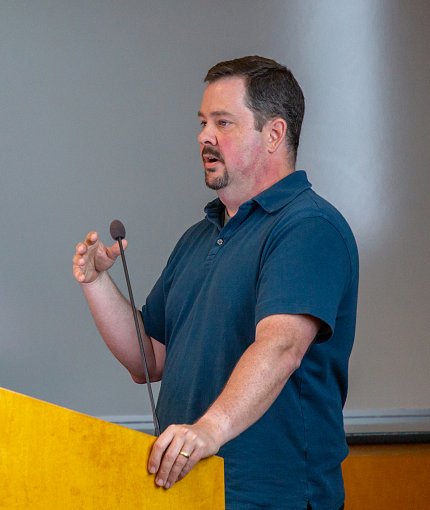Private Eye of Plumbing
NHGRI, CC Sleuths Uncover an Uncommon Bacteria

Photo: Mena Brunette
Using a cutting-edge NIH genomic center, a sophisticated microbiology lab and cross-disciplinary collaboration, experts at NIH were able to identify the source of a decade-long outbreak of rather uncommon hospital-acquired Sphingomonas koreensis infections, said Dr. Sean Conlan at a Biowulf 20th anniversary talk in Bldg. 50 held recently.
“Metagenomic analysis allowed us to identify and track the indolent outbreak that was really hard to see,” because it went on for 10 years, said Conlan, associate investigator in NHGRI’s microbial genomics section of the Translational and Functional Genomics Branch. This level of genomic DNA sequencing analysis had never before been applied to tracking a series of infections such as this.
The research is a collaboration between NHGRI and the Clinical Center’s Hospital Epidemiology Service and department of laboratory medicine. Conlan’s former colleague, Dr. Ryan Johnson, conducted most of the analysis. It wouldn’t have been possible without Biowulf, a state-of-the-art supercomputer that enables scientists in the NIH Intramural Research Program to analyze massive datasets and attempt projects whose sheer scale would make them otherwise impossible.
In 2016, the NHGRI branch, led by senior investigator Dr. Julia Segre, began to investigate a small cluster of 4 Sphingomonas koreensis infections in the CC over 6 months. Normally, the bacteria “is pretty low on the scale of things you worry about,” Conlan said.
The bacteria, which can be found in water, does not pose a risk to the vast majority of people across the country and even the vast majority of hospital patients. But a large number of patients at the CC are either highly immunocompromised when they arrive, or, as a part of their treatment, their immune system is wiped out in order to give them another chance at life, leaving them susceptible to a wide range of infections.
S. koreensis is a gram-negative, rod-shaped bacteria, Conlan explained. It has features that allow it to live in sterile water. The bacteria forms biofilms that protect them from sanitizers and common antibiotics. S. koreensis is intrinsically resistant, meaning it has natural resistance to nearly all antibiotics. That resistance can’t be transmitted to another species.
The NIH Intramural Sequencing Center sequenced six samples from severely immunocompromised patients. While all 6 cases were Sphingomonas bacteria, only 4 were the same species—S. koreensis. The 4 S. koreensis samples taken from the patients were 99.92 percent genetically similar, suggesting the samples belonged to the same strain.
To determine the source of the infection, investigators collected samples from several places in the hospital, including from the faucets of sinks in patient rooms. Researchers found genetically diverse, undisturbed bacteria growing in water that came from patient sinks and faucets. All water collected deep within the plumbing system of the hospital and incoming municipal water was negative for S. koreensis.
“They have been sitting in there and growing slowly in the nooks and crannies in a number of pipes,” Conlan said. “This improved our understanding of how we should be doing surveillance.”
As a result, in early 2017, the CC made several changes to the plumbing system. They replaced affected pipes and faucets and increased free chlorine levels and increased the temperature of hot water throughout the 3.3-million-square-foot building. The CC has not had a case of S. koreensis infection in more than 2½ years.

Photo: Mena Brunette
Conlan then jumped back in time to a separate outbreak in 2011. After the 2011 K. pneumoniae outbreak that affected 19 patients, the CC collected samples from the hospital environment to learn how antibiotic-resistant organisms spread. One of the goals of the study, published in 2014, was to learn how bacteria from patient and environmental samples share genetic material. It was the first study of plasmid transfer in a hospital environment.
Conlan said samples were taken from floor drains, housekeeping closets and carts, high-touch surfaces such as doorknobs and manholes on campus. Staff conducted whole-genome clustering to learn how organisms were related to each other and, more specifically, to learn about small, circular DNA molecules called plasmids that are contained in bacterial cells.
The plasmids can move from one bacterial cell to another and confer antibiotic resistance to other bacteria. In mixed populations of bacteria, plasmids can transfer antibiotic-resistance between different strains or species of bacteria—even without having been exposed to antibiotics. Recipient bacteria may go on to form persistent subpopulations or spread.
The study showed the tremendous value of accurate whole-genome sequencing to differentiate bacterial transmissions within the hospital from introductions of multidrug-resistant bacteria in patients who acquired them prior to admission at the Clinical Center.
While drain colonization with antibiotic-resistant bacteria is increasingly recognized as a patient safety risk in hospitals across the nation and around the world, Conlan said, “We found very few examples we could point to of the pipes being dangerous.
“This is a very active, dynamic process going on,” Conlan concluded. “And we hope this research helps us understand it better.”
